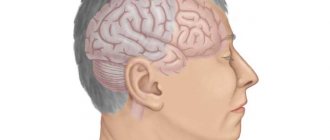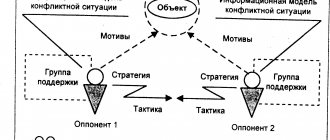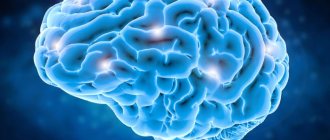Determinism
(from Latin determinare - limit, delineate, define boundaries, define) - the doctrine of the interconnection and mutual determination of all phenomena and processes[1], the doctrine of universal causation.
According to determinism, everything that happens in the world, including the course of human life and human history, is predetermined either by fate, or by the gods or by God (the doctrine of predestination, theological determinism
), either by nature (
cosmological determinism
), or by human will (
anthropological-ethical determinism
), or by the development of society (social determinism).
On this basis, the understanding of freedom is defined, including the conclusion that people essentially have no place for choice and, accordingly, personal responsibility.
In this form, determinism can be defined as the statement that there is only one, precisely specified, possible future.
Determinism can also be understood as fatalism.
The opposite of determinism is indeterminism[2].
Pierre-Simon Laplace was a proponent of absolute determinism. He postulated that if some intelligent being could know the positions and speeds of all the particles in the world, it could predict with complete accuracy all the events of the universe. Subsequently, such a hypothetical creature was called Laplace's demon.
The principle of determinism in science
Determinism as an idea of the interconnection of all phenomena and processes is the most important component of scientific methodology, aiming researchers at identifying causality and patterns in nature, society and thinking[1].
Classical physics is built on the principle of determinism. Thermodynamics and molecular physics pose a special issue in this regard. Determinism does not imply the reversibility of time, based on the assumption that the particle will not necessarily return to its original state when time is reversed, meaning that the trajectory will not always be uniquely determined by the final conditions. [ source not specified 144 days
]
The principle of determinism. Types and types of determinative connections.
⇐ PreviousPage 8 of 19Next ⇒Everything in the world is in motion, in interaction, interconnection (this connection is dynamic in nature). Everything is conditioned by something - this is the essence of the principle of determination. This principle is of great importance in spiritual, material, living, inanimate nature, in society. The Saratov philosopher Yakov Fomich Askin studied the principle of determinism for a long time. Types of determinative connections: 1) material determination is associated with the interaction in which matter, field, information are transmitted (meaning living nature). 2) the criterion here is temporary relationships. The present can be determined by the past, future and present.
a) past → present (cause and effect);
b) present → present (content and form);
c) future → present (possibility and reality, goal).
Determinative relations can be single-valued (necessity) and multi-valued (randomness).
Categories of cause and effect.
With the help of these categories, we condition and determine the present by the past. A cause is a condition that precedes the conditioned in time, is an active factor and gives rise to a consequence (the conditioned). Hume
said: “Before this does not mean because of this.” If night precedes day, this does not mean that night determines day. The causal chain is long, but only the last of the causes generates (P2 → P1 → Cl). The cause is an active factor. You cannot determine something without acting on it. The active factor is the cause, and the inactive factor is the condition.
When we talk about the creation of the world by God, there is no action, no changes in space and time, no expenditure of energy. God is the creator, but not the cause. Spinoza argued that nature is its own cause. The cause should not coincide with the effect in this case; one thing must give rise to something else.
Rest cannot be considered as the cause of movement (there is no generation). But there are spasmodic phenomena that occur suddenly, outside of time. Augustine the Blessed
said: God created the world out of nothing.
A cause-and-effect relationship (CAL) is something that arises from another something (rather than from nothing). PSS forms a chain of causes and consequences that goes on to infinity. The world has no beginning, since there is no specific first cause. The ancient Greeks understood various substances as the root cause; Aristotle
understood the prime mover (he himself is motionless, he moves others).
If we recognize the chain as closed (Plato)
, then it turns out that the effect is the root cause of the chain, which is the cause of the effect.
If cause and effect are simultaneous, then time is denied. A cause is a condition that changes over time. The cause begins to act and gradually fades away (completely at the moment the effect is formed). The effect influences the cause (it does not generate, but is a condition in which the cause operates). Dialectical philosophy claims that the true cause of all consequences is contradiction ( Heraclitus
said: everything is held together by war).
B33
Necessity and chance as categories of determinism.
These are types of deterministic connections. The connection between necessity and chance refers to the determination of the present by the present. There is no pure chance before the existence of necessity, and vice versa. Necessity means inevitability, regularity; something that can't help but happen. And an accident is something that may or may not happen.
Do necessity and chance exist objectively? Ancient philosophy stated: necessity exists, chance does not exist. Democritus put it more clearly; he has a subjective interpretation of chance: “Chance does not exist. Accident is an indicator of our ignorance of necessity.” As you learn, there are fewer and fewer accidents and more and more necessity. The concept of necessity has always been associated with regularity (for example, the laws of nature among the ancient Greeks).
Law and morality are not necessary. “You have to do it,” we say, assuming that a person cannot help but do it. But the concept of chance could not be connected with regularity. Accident was perceived as a deviation from the norm, law, rule. It is not clear how to explain the randomness. In antiquity, Epicurus spoke about the boundaries of freedom, about the spontaneous deviation of atoms from their trajectory. He turned chance into necessity, otherwise the connection of atoms would have been impossible. Democritus denied the objective nature of chance. But from the middle of the 19th century, with the development of biology and static physics (Laplace's theory), they realized that all this could not arise if the objective nature of chance was not recognized. With the advent of quantum physics, processes with independent reality were discovered. Those. randomness really exists.
Necessity and chance are interconnected. But there is still a point of view that they belong to different spheres of reality (there are 100% necessary phenomena and 100% random phenomena that do not interact with each other). In Hegel’s dialectics (later in Engels’s) N. and S. are one. There are two models of the connection between necessity and chance:
There are many real possibilities (there are conditions for them) and under given conditions only one of them can be realized. The process of realizing any one opportunity is an accident
Chance is the intersection of two necessities. This means that chance is part of the first and second necessities.
B34
Possibility and reality. Probabilistic understanding of the world.
V. and D. - these concepts were introduced by Aristotle to describe the process, movement, transition. The being of possibility is potential, the being of reality is actual. Possibility is potential, the ability of reality. Reality is a realized possibility. Existence is presented in the form of reality and possibility. Every reality contains a multitude of possibilities. Possibility is what will be reality, and changes in reality are determined by its possibilities.
Types of opportunities are identified (criteria - presence of conditions). A real opportunity is one for which the conditions for its implementation already exist. An abstract possibility is one for which the conditions for its realization do not yet exist. This practical difference is clearly visible in the examples of development. Human, social development is a new reality that emerges. We perceive it as the realization of possibilities, but at the same time, in the previous state there were other possibilities that cannot be realized, because there are no conditions for their implementation (formal possibilities). The development process becomes sequential (some opportunities are being realized, but others have not yet been realized).
When we make plans, we proceed from real and abstract possibilities. We must strive to realize real possibilities and create conditions for the realization of abstract ones.
The category of impossibility is of great importance. Leibniz put forward the thesis - “Anything can be!” This is strong, but wrong. If everything can be, it means that what cannot be can also be. Perhaps not everything - it is foolish to look at any economy that solves any issues. This does not mean that a certain type of economy contains unlimited opportunities. Some needs are realized, others are rejected and not realized. A well-fed, rich person has no need for harmony, justice, or knowledge. English The philosopher Whitehell said: “every law contains a prohibition.” Any general judgment suggests that there cannot be another.
Impossibility is useful because... we understand why the development process is irreversible. Some reality moves to the level of impossibility and never returns to reality. Possibility is a form of being (it is not “that which does not exist”).
B35
Categories of spirit, soul, consciousness in the history of philosophy. Substantial and non-substantial understanding of consciousness.
SPIRIT (from Latin spiritus lit.: “breath”, “subtle air”) - in a broad sense, a concept expressing the ideal principle from which comes the creative force that improves and raises man and the world to the absolute, unconditionally valuable. In a narrow sense, spirit is identified with thinking. In general, the concept of spirit helps a person to understand himself as a being, open to the world, improving and free.
The ancient understanding of spirit is cosmological, impersonal, rationalistic. He enters in the form of Nous - the idea of ideas, cosmic thought thinking itself, the prime mover shaping chaotic matter (Aristotle); in the form of Logos - the meaningful word of the world, the law that establishes order and harmony in it (Heraclitus). For Plato, the spirit is the most sublime, rational part of the soul, diffused throughout the body. At the same time, the human mind is part of the world spirit. However, the spirit was also understood as a super-intelligent principle, cognizable directly, intuitively (Plotinus).
Christian medieval philosophy (Augustine the Blessed) considers the spiritual and the physical as the beginnings of the dual nature of man. The main ability of the human spirit is faith in God. The third hypostasis of the Divine Trinity - the Holy Spirit - is omnipresent, eternal, omnipotent, miraculous, and has the power of life-giving. He is in mystical union with the church. Human spirituality is directly addressed to him and inspiration comes from him.
Starting from the philosophy of modern times, there has been a growing tendency towards subjectivization, an understanding of the spirit as a universal human personal principle. This line clearly emerges in German classical philosophy, starting with Kant’s teaching about the transcendental subject (an abstract representation that concentrates a person’s cognitive abilities). Representatives of German Class. idealism emphasized the activity of the spirit, considering it, first of all, from the perspective. activities of self-awareness. Thus, Hegel understood the spirit as the unity of self-awareness and consciousness, realized in the mind, as the unity of practical and theoretical activity: the existence of the spirit is its action, although this action is understood only as knowledge. The spirit, according to Hegel, goes through the stages of subjective (personal) spirit, objective spirit (law, morality, morality) and absolute spirit (art, religion, philosophy). With the help of philosophy, the spirit overcomes the natural, sensual and rises to itself in the process of self-knowledge.
Materialism views spirit as secondary to matter. Materialists of the 17th–18th centuries. (Hobbes, Locke, La Mettrie) understood D. only as a combination of sensations, a general feeling. Dialectical materialism connects it with the human process. activities. The spiritual is a special, highest result of the material, socio-historical practice of people.
In the philosophy of life, intuitionism, and existentialism, views on the spirit as an irrational phenomenon are spreading, which determines the unlimited creative power of the individual, his ability for free communication (Bergson, Berdyaev, Shestov, Jaspers, Lossky, etc.). Berdyaev believed that the spirit is the divine element in man, manifested in love, kindness, compassion, etc. Consequently, the spirit lies not in objectivity, but in subjectivity. Therefore, no rational concept can be given about it.
SOUL is historically the first term used as a synonym for the term psyche. In the history of philosophy, this concept expressed views on the inner world of man, identified in idealism with a special immaterial substance.
At the first stages of the development of philosophy, SOUL was considered as an impersonal principle, devoid of the uniqueness and individuality of the human personality. The properties of the soul were associated with the properties of the cosmos: human activity. I had not yet opened my soul.
Thus, for Plato, the human soul is incorporeal, immortal and indestructible, containing three unequal parts (reasonable, volitional and lustful). The human mind connects him with the cosmic spirit - the world of ideas. The task of the soul is to subjugate the physicality and try to earn a better fate in a new body after death. Plato develops the doctrine of the world soul, which connects the world of ideas and the world of things, rules them, and gives creative vitality to the macrocosm. Thus, the macrocosm - the world - is depicted as a perfect living being. According to Plato, the three-component structure of the human soul corresponds to the structure of the soul of the macrocosm. The acquisition of true knowledge is associated with the process of the human soul remembering its stay in the world of ideas.
⇐ Previous8Next ⇒
Literature
- Hoefer, Karl. Causal determinism // Stanford Encyclopedia of Philosophy (Spring 2020 version) / Ed. Edward N. Zalta. Per. from English A.V. Mertsalova.
- Ivanov V. G.
Determinism in philosophy and physics. - L., 1974. - 183 p. - Ivin A. A.
Logical study of determinism // Philosophy and culture. - 2008. - No. 9. - Ivin A. A.
Truth, time, determinism // Polygnosis. - 2008. - No. 3. - Kuptsov V.I.
Determinism and probability. - M., 1976. - 256 p. - Lebedev S. A., Kudryavtsev I. K.
Determinism and indeterminism in the development of natural science // Bulletin of Moscow University. Series 7. Philosophy. - 2005. - No. 6. - P. 3-20. - Lukasevich J.
On determinism // Philosophy and logic of the Lviv-Warsaw school. - M., 1999. - P. 179-198. - Orlanov G. B.
The idea of determinism: historical development trends // Determinism and modern science. - Voronezh, 1987. - P. 9-23. - Pakhomov B. Ya.
Determinism and the principle of development. // Questions of philosophy. - 1979. - No. 7. - Sokuler Z.
A. The debate about determinism in French philosophical literature // Questions of Philosophy. - 1993. - No. 2. - Spontaneity and determinism / V.V. Kazyutinsky, E.A. Mamchur, Yu.V. Sachkov, A.Yu. Sevalnikov, etc.: Institute of Philosophy RAS. - M., 2006. - 323 p.
- Bunge M.
Causality: The place of the principle of causality in modern science. - M.: Foreign Literature Publishing House, 1962. - 513 p.










